The east window of St Anta and All Saints, Carbis Bay, Cornwall, UK and the Cornish Revival

High-resolution image will start to load shortly …
Contents
- A new church for Carbis Bay
- The New East Window
- Description of the East Window
- The Magnificat in Cornish, the Coronation of the Virgin and emblems of St Petroc and St Germans
- The Paradox of the Trinity in Cornish, another emblem and a Duchy of Cornwall emblem
- The opening words of the Te Deum in Cornish and Christ’s Passion
- The Saints with Mother and Child
- Dedication and Choughs
- Maker’s Mark and Date
- Cornish Connections
- Conclusion
- Acknowledgements
- References
1. A new church for Carbis Bay
In , John Bartholomew's Gazetteer of the British Isles described Carbis Bay as:
Carbis Bay, hamlet with station on the Great Western Railway, W Cornwall, 1¼ mile SE. of St Ives.
Until recent times, Porthrepta fishing cove, the Providence Mines and the numerous farming hamlets now in
Carbis Bay were a part of Lelant, with the parish church a mile or so to the east.
The name ‘Carbis Bay’ arrived with the railway in ,
as did the visitors who swelled the population until
Carbis Bay needed its own church and chapels.
In the early decades of the 20th century, there was a small,
wooden Mission Church in Carbis Bay (on the
opposite side of Porthrepta Road to the present church). By
it was too small for the growing
congregation and there was a ‘new church building fund’1
On the St Ives Times reported:

In , while additional funds were raised,
tenders were issued for the building of the new church.
Newspaper reports state the architecture will be Norman, with square tower. Exterior dressings of Cornish
granite are provided for
.2
The St Ives Times reported that The style is English Gothic, influenced by certain
characteristics found in Cornish Architecture, Cornish Granite being used for the
building.
3
In of that year Mrs Tyringham of Trevethoe, Lelant, performed the ceremony of laying the
foundation stone.
4

CORNWALL CEREMONY.—Laying the foundation-stone of the new church to be erected at Carbis Bay, a ceremony attended by clergy from all parts of the diocese.—Photo: Sandy.
Picture from the . Image © Trinity Mirror. Image created courtesy of THE BRITISH LIBRARY BOARD.
The church was initially named All Saints in view of the fact that the church was
intended not only for residents of Carbis Bay but for the numerous visitors who came to the
neighbourhood.
4

NEW CHURCH at Carbis Bay which is nearing completion and will be opened shortly.—Photo: Harvey, St. Ives.
Picture from the . Image © Trinity Mirror. Image created courtesy of THE BRITISH LIBRARY BOARD.
In the Church was dedicated by the Bishop of Truro,
Dr Walter Frere. The Cornishman reported
the event under the headline An impressive ceremony and a fine building
and, as well as reporting the
activities of the day and the attendees, said The organ which is being used at present is small but both
musical and sightly. The ewer of the font is of beaten copper and has been designed by Mr R Dick of Newlyn
who also designed and made the alms dish. On Friday morning … ceremonies were followed by the solemn
singing of the Holy Eucharist …. There was a good congregation and about 40 communicants. In the evening
Evensong was sung for the first time in the new church.
5
The Bishop also said The church is not yet complete, as its sponsors have in view the possible need of an
extension; the last four bays of the nave have still to appear, as well as the upper portions of the Tower,
because Carbis Bay is growing, both in its normal and summer population.
5
Clearly further additions to the
church were expected. An Organ built by Sweetland of Bath was installed in
.6
The next substantial alteration was the new glass in the East Window, directly above the altar. There are
pictures of the interior of the Church pre-1940 showing plain glass in the East
Window7:
this was replaced by the new stained-glass memorial window in .
By then the donor for the new church had been identified as Fenwick Richards, one of the people
commemorated in the new window. He was born at Venwyn, a farm on Laity Lane, and was baptised
Timothy Fenwick Jose Richards in St Uny Church, Lelant, on .
He grew up at Venwyn and was there when the
census was taken, with elder brother Charles and their father and mother, Charles and Ann Richards.
Fenwick Richards left Cornwall for Bristol before
where the census of that year finds him as a Boarder
in St James, a Tobacconist’s Clerk. By he was still
a Boarder but by then an Accountant. In he
married Grace Davey in Clifton, Bristol.
Sadly by he was a widower with one daughter, living in Clifton,
Bristol, described as a Tobacco Manufacturer. By
he was living at Dundonald House, Westbury on Trym, Barton Regis, Bristol,
described as a Tobacco Merchant, with his daughter. Notes in the St Ives Archive
describe him as chairman of WD & HO Wills (Woodbine) of
Bristol.7
By Fenwick was 78 and a retired
tobacco manufacturer. He was never to return to live in Cornwall
but was well known in Bristol, a Councillor
and listed in the Bristol Directory. He died in ,
aged 94, in Bristol.
Canon Jennings said, of Fenwick Richards,
he was a director of the Imperial Tobacco Company and gave the
money to build the church at Carbis Bay
and continued
when he left his home, [he] never forgot his native
place and … foresaw better than most people how Carbis Bay would grow. [Canon Jennings] well
remembered how Bishop Gore, years ago, used to receive at Christmas time £1000 to be put towards the
building of the Church at Carbis Bay. The speaker was one of the few who knew where that money came
from. He [Fenwick Richards] loved this place and I know he rejoiced over the blessings vouchsafed to this
church which he so ably helped to
build.
8,9
Subsequently, in , the church tower was raised and, in the 1960s, an additional four bays of the nave added to complete the church as we see it today. Improvements continued to be made; new choir stalls of Oak, crafted by St Ives woodworker Robin Nance were installed in 1969/70.6
2. The New East Window
In the St Ives Times announced a service to dedicate a new memorial window in Carbis Bay Church.

All Saints’ Church, Carbis Bay. The new east window will be dedicated on by the Revd. Canon H. R. Jennings.
The Cornishman report of the event starts Canon H. R. Jennings, on Saturday afternoon dedicated a new
stained-glass window at All Saints’ Church, Carbis Bay, presented by Mrs A. E. Lemon in memory of her
relatives. Canon Jennings was a friend of each of the people commemorated by it. Rev. A. H. Mock (Priest-in-Charge at All Saints’)
conducted the service.
8
Canon Jennings described the window thus The five main lights of the window (the work of Mr M. H. N. C.
Atchley of Bristol and Perranarworthal) are filled with figures of St. Barnabas, St. Francis, the Blessed Virgin
Mary and the Divine Son, St. Euny and St. Anta, the first two at the donor’s request. The fourth is the patron
saint of the old parish church, and the fifth gives her name to Lelant (Lan-anta). Beneath some of these
figures are choughs. Above these saints are symbols of our Lord’s Passion, arranged according to the Cornish
tradition, together with the first two verses of the Te Deum in Cornish.
At the head of the central light is the
beautiful shield assigned to the Holy Trinity with its wording also in Cornish.
8
The St Anta & All Saints East Window has similarities to many other Cornish Stained-Glass Church windows.
Michael Swift of Cornish Stained Glass says A unique theme that became prominent in twentieth-century
windows in Cornwall was that of the Cornish Saints. In the absence of early documentary evidence on the
lives of most of these saints, the designs usually took the form of an idealised figure, or an event drawn from
the Saint’s legend. Early examples included St Carantoc in his coracle at sea discovering the floating altar
guarded by an angel, and St Kew with her attribute of a bear. Many of the parish churches that are dedicated
to a Cornish saint included a representation in their windows.
10
The St Anta & All Saints window, however, introduced something new. Another uniquely Cornish element to
appear in stained glass was the Cornish language. In , two new windows included Cornish inscriptions:
at Carbis Bay the window included the first lines of the Te Deum,
and at King Charles the Martyr, Falmouth,
the inscription was Epscobeth Kernow: Onen Hag Oll. … the Falmouth design included many other Cornish
themes besides the Cornish inscription. The arms of the Diocese of Truro and the Duchy of Cornwall appeared, along with
the fictitious arms of SS Germans and Petroc, the main figures were four local Cornish saints, and there were also
two emblematic Cornish choughs. Intriguingly, in the succeeding 70 years the inclusion of Cornish
inscriptions has not been repeated in any other Cornish window.
10
3. Description of the East Window
3.1. The Magnificat in Cornish, the Coronation of the Virgin and emblems of St Petroc and St Germans
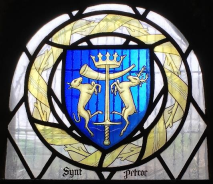
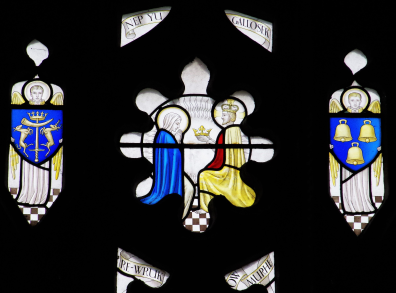
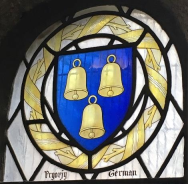
At the very top of the window are:
-
A line from the Magnificat, in Cornish, which reads:
The Magnificat in full, in Cornish, with score, can be found here.Centre, above: NEP YU GALLOSEK He who is mighty Centre, below: RE WRUK OW MURHE has made me great (magnified me) - On the left is an angel holding a shield with a crown, a hunting horn, a sword, a deer and a stag, an emblem for St Petroc. Petroc was a sixth-century saint, born in Wales, associated with Padstow and Bodmin. Petroc is generally portrayed with a stag; he is said to have converted Constantine of Cornwall to Christianity by saving a deer Constantine was hunting.11a,11c This emblem thus includes references to Constantine (the crown and the sword), hunting (the horn) and animals sheltered by the saint (the deer and stag). It also appears in the designer’s window in Falmouth, named Synt Petroc (as shown on the left above).
- In the centre is the Coronation of the Virgin. Tradition believes that on her entry to heaven the virgin was crowned by the angels and given a place of honour.7
- On the right is an angel holding the Three Bells, an emblem for the See of St Germans, the ancient Cornish See.11b This also appears in the designer’s window in Falmouth, named Pryorjy German (as shown on the right above).
3.2. The Paradox of the Trinity in Cornish, another emblem and a Duchy of Cornwall emblem
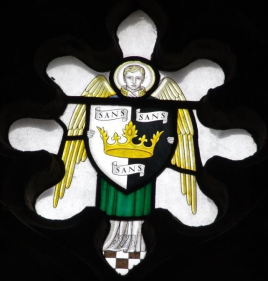
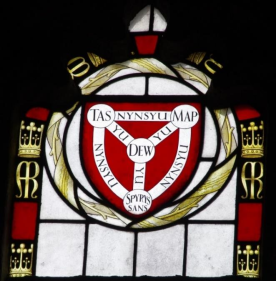

-
On the left is an emblem showing an angel holding a shield with crown and the word SANS
(holy, sacred or saint in Cornish) three times on a black and
white background. The black and white background is often used as a symbol of Cornwall.
The writing reads ‘Holy, Holy, Holy’ which is both a reference to
the Trinity and part of a line in the Te Deum,
Sans, Sans, Sans: Arluth Dew a Sabaoth
orHoly, Holy, Holy, God of Power and Might.
12 The crown would be the symbol of theGod of Power and Might.
-
In the centre, a shield showing the paradox of the Trinity with the wording in Cornish.
To each side of the shield is a crown and a capital M, the medieval insignia for Maria—the Virgin Mary. This was used extensively in windows of the 15th and 16th centuries.13aCornish English TAS Father MAP Son SPYRYS SANS Holy Spirit DEW God NYNS YU Is Not YU Is - On the right, an angel holding a shield with 15 bezants, a symbol associated with the Duchy of Cornwall, taken from the arms of the ancient Earls of Cornwall7
-
Four red roses (one of which is shown below), one at each side of the three elements; the rose was another symbol of the
Virgin Mary.13a
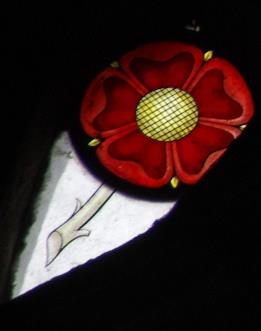
3.3. The opening words of the Te Deum in Cornish and Christ’s Passion

This panel has two components. Above the pictures are the opening words of the canticle ‘Te Deum’, used in the Anglican service of Morning Prayer, in Cornish:13a
| TY A DHEW A WORMELYN | TY A-ASWONYN YN ARLUTH | OLL AN NOR | A-TH-WHORTH-SY | AN TAS NEFRA A-BYS |
| We praise you O God | We recognise you as the Lord | All the earth | worships you | The father everlasting |
The full morning and evening services in Cornish can be found here or the morning prayer alone here.
In pictures below the writing are the symbols of the Passion7 which, reading from left to right, represent the:
- nails which pierced the hands and feet of Jesus,
- scourges with which he was beaten,
- five wounds, the pierced heart, hands and feet,
- spear and the sponge on a reed,
- thirty pieces of silver paid to Judas Iscariot.
3.4. The Saints with Mother and Child
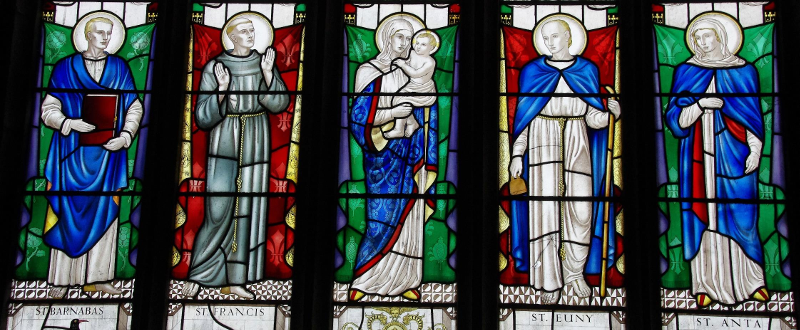
The main panels of the window depict:
- St Barnabas, a Cypriot Jew, an early Christian and companion of St Paul on his early missionary journeys. In art he is represented carrying a book, a copy of St Matthew’s gospel.14
- St Francis of Assisi, who founded an order of Friars which became the Franciscans, known as Grey Friars.15
- The Virgin Mary with child Jesus.
- St Euny, a missionary preacher who is the patron saint of both Lelant and Redruth, who was said to have summoned people to his preaching with a bell.16
- St Anta, who gave her name to Lelant (originally recorded as Lananta—the Lan, sacred enclosure or church, of St Anta).17 She is patron saint of Carbis Bay church.
These four saints give the window a message of Christian mission. St Barnabas was companion to St Paul in his mission to the Gentiles. St Francis established the one monastic order that was specifically aimed at the poor and dispossessed. The two Cornish saints are both examples of the early mission saints from Ireland and Wales.17
3.5. Dedication and Choughs



At either side of the base of the window is a Cornish Chough.
In the middle is the dedication:
RECEIVE O LORD THE SOULS OF THY SERVANTS
JAMES FREDERICK LEMON : PRIEST : FENWICK
RICHARDS : CHARLES RICHARDS & JANE HIS WIFE OF
VENWYN AND THEIR DAUGHTERS JANE & ELLEN
3.6. Maker’s Mark and Date
The maker’s mark and date are on the far right of the right-hand chough, at the base.
The maker’s mark is a cross rebus identifying the maker as J Wippell of Exeter.18
In the 1930s Wippells were the nearest stained-glass studio to Cornwall.13a
J Wippell & Co Ltd are still in business, describing themselves as Clerical Outfitters and Church Furnishings
since .
They still supply and install stained glass windows and restore them.19
The date is 193?, probably (given that the window was dedicated in ).
4. Cornish Connections
How did this window, with its Cornish emblems and Cornish language, come to be installed in a modern church in Carbis Bay in the middle of the 20th century?
It cannot be a survival of original Cornish as that had fallen out of everyday use many years before the window was created. It must be a product of the Cornish language and cultural revival which was taking off at that time.
All the people involved are long gone and none can tell us whose idea this was, or what conversations were had developing the idea before the Window was created. There is, inevitably, some speculation in what follows—the people, dates and events are real but how they came together is not known for sure. A picture emerges, however.
4.1. The Richards Family of Venwyn
Anne Elizabeth Lemon presented the window in memory of her family—her husband, James Lemon, her uncle, Fenwick Richards, her parents, Charles and Jane Richards, and her sisters, Jane and Ellen Richards.
Anne herself was born in , Anne Elizabeth Richards, and baptised in St Uny Church on . In the census we find her, aged 4, at Venwyn Farm, on Laity Lane (now Carbis Bay but then Uny Lelant). She is with her father, Charles Richards, a farmer, her mother, Jane Richards, her older sister, Jane Mayne Richards and her younger sister Eliza Ellen Richards. In the census (extract below) we find the same small family at Venwyn, with a visitor, her uncle, Fenwick Richards (the key donor for the new Carbis Bay church many years later).

In the census the Richards family were still at Venwyn, Charles Richards aged 58, farming. Anne and Eliza were at home on census night but sister Jayne Mayne Richards was visiting an uncle (her mother’s brother) James Mayne, rector of Romansleigh Devon, in Newton Abbot. In the Richards family were still at Venwyn, Charles Richards at 68 still farming. Jane and Anne were at home but Eliza was a visitor in Penzance on census night.
As Canon Jennings says of the Richards family when dedicating the new window the window they were
dedicating that afternoon, with its charm, colour and form, was to remember a family whose dedication to the
church was very marked. It was 50 years since he (Canon Jennings) first knew the family and in all that time they
had never wavered in the highest principles of the Christian Church.
8
Of the three sisters, Jane, Anne and Eliza,
Canon Jennings says when he (Canon Jennings) was at St John’s Penzance, they were ready helpers in all our good
works and faithful servants of the Church and generous donors to our funds.
9
By the 1890s, at the time Canon Jennings first knew the family, all three daughters were in their 30s, unmarried, clearly very involved in the Church. The first to leave home was Anne who married James Frederick Lemon in at Marazion.
James Lemon was born in in Germoe.
At 14, in , he was a pupil at Newton College in Newton Abbot
but he returned to Cornwall and at 24, in ,
he was Curate of Lelant and Towednack. Presumably this is when
he met the Richards family, as Venwyn Farm was in Lelant parish. Canon Jennings said of him
James Lemon showed great kindness to me when I was a young
clergyman.
9
By James Lemon is in Marazion, aged 34, a widower living in Fore Street with his mother, and a clerk in Holy Orders. In he marries Anne Elizabeth Richards, the middle daughter of the Richards family and the one who, eventually, presents the Window. They marry in Marazion and in James and Anne Lemon are living in Fore Street, Marazion, and he is a Clergyman of the Church of England. By James Lemon is vicar of St Hilary and James and Anne are living in the Vicarage.
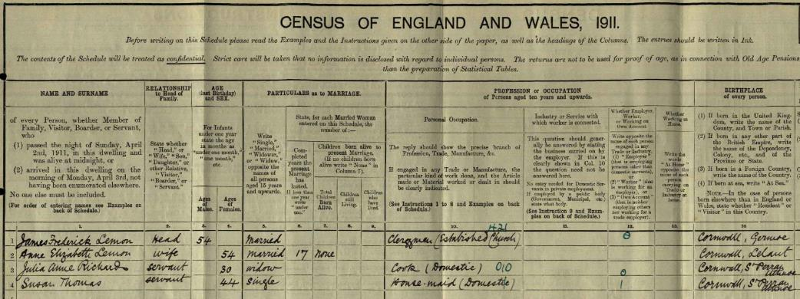
They were in their mid-fifties and had no children and the following year, in , James died and was buried at St Hilary Church.
But what of the rest of the Richards family at Venwyn? In , a couple of years after Anne married, her father, Charles Richards, died and was buried in the Churchyard at Uny Lelant. By , the family have left Venwyn Farm and mother Jane Richards is a widow aged 71 living at 1 Clarence Place, Penzance with daughters Jane and Eliza, both now in their 40s (see census below).

In mother Jane Richards died, aged 77, and was buried alongside her husband in Lelant Churchyard. In Anne’s two sisters, Jane and Eliza, were living in 1 Clarence Place, Penzance.
Jayne Mayne Richards is recorded on the Electoral Roll for , still in 1 Clarence Place. She died in , aged 75, and is buried with her parents in Lelant.
By the two remaining sisters, Anne Lemon and Eliza Ellen Richards, had moved to Falmouth. They were both on the Electoral Roll in Falmouth, Anne in Trevaylor and Eliza in Western Ridge. Then, in , Eliza Ellen Richards died, aged 72, in Falmouth. She was buried with her parents and sister in Lelant churchyard. The grave to the Richards family of Venwyn is on the left-hand side shortly after entering the churchyard from the church side.
The remaining member of the Richards family, Anne Elizabeth Lemon, lived on in Falmouth and was still there, aged 82, in Pennance Road, in the Register. She died, aged 94, in Falmouth in .
The memorial window was installed in early
but made in , and presumably commissioned a few years
before that (allowing time for gaining permissions and creating the design).
It was probably conceived in the mid 1930s, not so long after
the death of Ellen Richards in .
The others commemorated had died many years before—Charles Richards in
, Jane Richards in
, James Lemon in ,
Fenwick Richards in ,
Jane Mayne Richards in .
According to Canon Jennings The last survivor of that group, who had seen them all pass on,
had given the Window
.8
Now we know a little more about all the people to whom the window is dedicated:
RECEIVE O LORD THE SOULS OF THY SERVANTS
JAMES FREDERICK LEMON : PRIEST : FENWICK
RICHARDS : CHARLES RICHARDS & JANE HIS WIFE OF
VENWYN AND THEIR DAUGHTERS JANE & ELLEN
Whilst the Richards and Lemon families are clearly central to the story of the window, there is nothing to suggest they had any association with the Cornish revival or the Cornish language, beyond the support evidenced by giving the window. They were clearly dedicated to the Church and Anne Lemon selected two of the Saints for the window (St Barnabas and St Francis)8 perhaps introducing the theme of Christian mission to the window.
4.2. Canon Jennings
Perhaps Canon Jennings, who led the service of dedication for the window, introduced the distinctively Cornish elements to the window design?
The Rev Canon Henry Richard Jennings was born in in Suffolk—his father was from Driffield in Yorkshire, his mother from Diss in Norfolk. He was baptised in St Stephen, Ipswich and grew up there—he is with his family in Ipswich aged 4 in the census and again, aged 14, a scholar, in . By , however, aged 24, he had moved to Cornwall and was living in Alma Terrace as a Curate of St Johns Penzance. In he married Susan Milton in Penzance and by they were living in the Vicarage at Millbrook, St Germans where he was a Clergyman. In , Canon Jennings was back in Penzance, a Clergyman living at St John’s Vicarage with his wife Susan and six young children, all born at Millbrook. In Canon Jennings became Vicar of Madron Church, where he remained for nearly 20 years.22
Canon Jennings clearly took his new homeland to his heart and in ,
at the second Gorsedh Kernow, he was
made a Bard with the name Saws Degemerys
which he translated as An Englishman
who has been made welcome
20
Gorsedh Kernow, or the Cornish Gorseth,
was described as a College of the Cornish Bards
and not political or
anti-English
but exists to maintain the National Celtic Spirit of Cornwall and to give expression to such spirit: to
encourage the study of Cornish History and the Cornish Language; to foster Cornish Literature, Art and Music; to
link Cornwall with other Celtic countries, and to promote a spirit of peace and co-operation among those who
work for the honour of Cornwall.
21
On Canon Jennings’ retirement from Madron Church in , the
Cornishman and Cornish Telegraph reported
There are always some figures in a district whom everyone seems to know—and Canon Jennings
is one of these.
He will be greatly missed not only in the parochial life of Madron and the ecclesiastical life of West Cornwall but in
many other ways, amongst which might be instanced his work as Chaplain of the Order of St. John of Jerusalem;
his talents for historical and archaeological research, which have made him so valuable a member of the Old
Cornwall Society; his efforts in the cause of literature, both by his tenure of the chairmanship of the Morrab Library
of Penzance and by his own publications; and his interest in all things Cornish by reason of his being a
Bard.
22
In a Presentation to Canon and Mrs Jennings was held in Penzance when
the Lord-Lieutenant of Cornwall,
the Bishop of Truro, clergy and parishioners of the district and representatives of Cornish Culture assembled at
St. John’s Church, Penzance to pay their tributes on the anniversary of his sixty years in the
ministry.
20 Canon
Jennings died in at the age of 85. He is buried in Penzance Cemetery.
It seems highly likely that Canon Jennings, knowing the family well, was able to suggest a Cornish theme for the window, being well connected via Gorsedh Kernow. But could he have written the Cornish?
When Jennings was made a Cornish Bard they were few in number. 14 people become Bards in Wales or Brittany
before the first Gorsedh Kernow in , 12 more were admitted there.
11 further Bards were admitted in ,
including Canon Jennings, making just 37 in total, four of whom were
Clergymen.23 It is safe to say they would all
have known each other at that early stage.
They would not all have known Cornish, however,
being admitted by invitation for work done for the cause of Cornwall as a Celtic
nation
24 But if Jennings did not
know Cornish himself, he certainly knew people who did. And he may well have suggested a window of
distinctively Cornish design, and a designer who could create such a window.
4.3. Max Heriot Nevil Cuthbert Atchley
The designer of the window was Cuthbert Atchley.13b Max Heriot Nevil Cuthbert Atchley was born in in Barton Regis, Bristol and baptised on in Clifton, son of Edward Godfrey Cuthbert Frederick Atchley and May Florence Heriot Atchley. In the census, he was just three, by he was 13 and a scholar, living at 23 John’s Road, Clifton, Bristol.
His father, Edward Cuthbert Atchley was an English surgeon and Anglican
liturgical scholar.25
Amongst many
other publications, he wrote Essays on Ceremonial,
A History of the use of Incense in Divine Worship,
An Early History of Divine Service and
An Introduction to English Liturgical Colours. Many of his titles were published by
the London Society for Promoting Christian Knowledge. He was associated with the Alcuin Club which plays a
significant part in the liturgical life of the Church. Founded in
it has a long and respected tradition of
promoting sound liturgical scholarship.
26
Clearly Max Cuthbert Atchley will have grown up with a good
knowledge of Church ritual and symbolism.
It is not clear when Max Cuthbert Atchley moved to Cornwall, but he had family connections with Cornwall. His grandmother, Georgiana Atchley, was born and brought up in Liskeard, daughter of the Revd James Frederick Todd. His grandfather on his mother’s side, Richard Hill, was a Cornish farmer’s son, born and brought up at Tregair, Gerrans (and shown there in the census below).

In the 1920s and 30s, Max Cuthbert Atchley contributed several articles to the Old Cornwall journal.27a He also contributed to two publications on Cornish Churches.27b
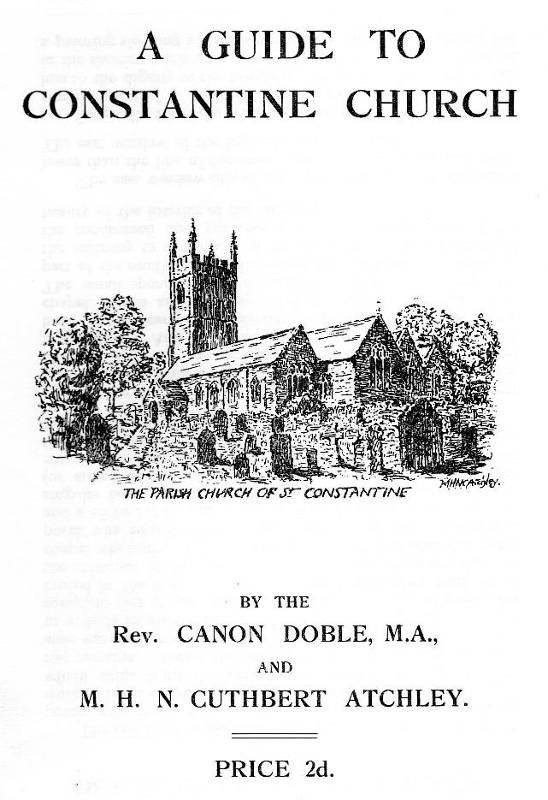
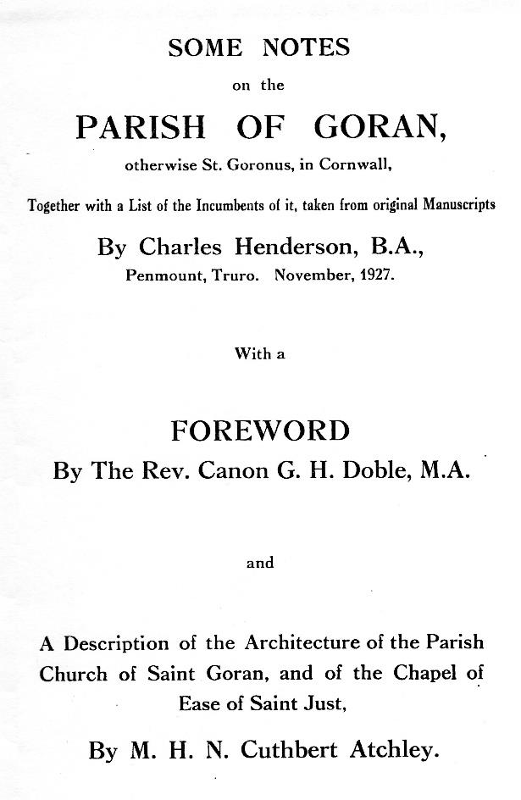
The first (on the left above) was a small leaflet, A Guide to Constantine Church published around , with the Revd Canon Doble. Reverend Canon Gilbert Hunter Doble was another early Bard, admitted in as Gwas Gwendron (servant of Wendron).27 Gilbert Doble published a series of histories of Cornish Parishes and the Cornish Saints Series.28 He could have given Cuthbert Atchley plenty of material on the Cornish Saints to incorporate in his window designs.
Cuthbert Atchley collaborated with Gilbert Doble and others on the second pamphlet (on the right above) about St Goran Church, dated , in which the collaborators are acknowledged as follows:

By this time, as well as an authority on Cornish Church Architecture, Cuthbert Atchley was also a Bard of
Gorsedh Kernow.
He was admitted in taking the Bardic name
Gwas Gerrans (Servant of Gerrans).23
By , candidates for bardship could be admitted by examination
in Cornish language and literature, though in
those early days of language revival it was only necessary to write Cornish,
not speak it.29
The Gorsedh Kernow archives record, however, that Cuthbert Atchley was
Greatly interested in a wide range of Cornish activities which include wrestling and the Cornish Language [and is]
believed to have been involved with Morton Nance in compiling the Cornish dictionary.
Whether he took the exam or not, he was clearly familiar with the Cornish Language.
The archives also reveal that he was Best remembered for restoring the stained-glass windows at
St Neot.
”27a
In the late 1930s Max Cuthbert Atchley designed two stained glass church windows incorporating Cornish symbols and writing. The first, installed in , can be found in the South Aisle of the King Charles the Martyr parish church in Falmouth.17 It contains only a few words of Cornish. His second window, larger and more prominent in the Church than the first (and containing far more Cornish) is the East window in St Anta and All Saints’ Church.
In both windows Cuthbert Atchley drew on established Cornish symbols (the Diocese of Truro in the Falmouth window and the Duchy of Cornwall in both windows) as well as stories of the Cornish Saints. But there are also emblems in the windows which may be his creations, albeit probably based on depictions of these subjects in other Cornish churches.
The story told about St Petroc is that he converted Constantine to Christianity by saving a stag Constantine was
hunting. William Borlase describes Constantine as a heathen landowner
and recounts the story A stag, hard
pressed by hunters, flies for refuge to the little enclosure where the holy man resides. The servants of Constantine,
well knowing that, if they snatch the animal from its sanctuary, they will incur the malediction of the Saint (since
kindness to dumb creatures was ever a characteristic of a hermit’s life), go and make their report to their master.
Furious at being baulked of his prey, he seeks to do the saint some deadly hurt, but at the thought his body turns
rigid and in terror at the miracle, he becomes a convert.
30
In the Guide to Constantine Church, Cuthbert Atchley
describes Saint Constantine
as a Cornish King who became a monk, perhaps in the
sixth century.
27
The emblem for St Petroc in both his windows shows a crown, a hunting horn, a sword, a deer and a stag—clearly
relating to this story (accepting Constantine as a Cornish King).
In Cuthbert Atchley married in Truro and by the Register he was a Registered Architect living at Trewinnard House, a large, Edwardian residence on St Piran’s Road, Perranwell Station, between Truro and Falmouth.31 He died shortly afterwards, however, and was buried in Perranarworthal Churchyard in . There have been no more stained-glass windows including the Cornish Language since he died.
How was Cuthbert Atchley brought in to do the window design? Perhaps he, or his father, knew Fenwick Richards in Bristol; they lived in the same areas at the same time. That was many years before the window was designed, however. Perhaps Anne Lemon saw his first church window installed in Falmouth, where she lived, and asked him to design her window too. But the timing is tight; the second window would have to have been designed and made very quickly. More likely, Canon Jennings, knowing Anne Lemon’s wish to dedicate a window to her family, introduced Cuthbert Atchley, a fellow Bard, as a potential designer who would give the window a distinctively Cornish look.
Did Cuthbert Atchley know sufficient Cornish to create the translations for the window? It seems likely. There is one more Bard who may have been involved, however, although his name does not crop up anywhere in reports about the window.
4.4. Robert Morton Nance
Robert Morton Nance lived close by St Anta and All Saints’ Church at Chylason, on Porthrepta Road, Carbis Bay from to his death in .32 Morton Nance was founder of the St Ives Old Cornwall Society, a founder member of Gorsedh Kernow and its Grand Bard from to . He established a Cornish grammar (based on medieval Cornish texts that have survived), standardised spelling and complied a Dictionary,33 Cornish for All, first published in .34 He was the foremost Cornish scholar of his generation and dedicated to the revival of Cornish culture and language.
Yet Robert Morton Nance, in his own words “did not attend church and did nothing to support forms of religion.”35 His parents married in the Wesleyan Chapel in St Ives,36 so his upbringing would have been Methodist, if at all religious. His second marriage was in an Anglican Church in Swansea, the Chapel of Ease of St James, so possibly his wife, Annie Nance, was an Anglican, perhaps she attended St Anta and All Saints’ Church? Yet his daughter Phoebe’s wedding, in , was not held at St Anta and All Saints but at the parish church in Zennor37, where Phoebe was living at the time. There is, however, one link with St Anta and All Saints. Phoebe’s wedding was carried out by Revd AH Mock, Priest in Charge at Carbis Bay. Revd Mock was also present at the memorial window dedication service just two years after the wedding.8,9
Given his views on church, Morton Nance will not have been the initiator of the window but given that he knew
so many people involved with the window he would surely have been aware of it and supported its use of Cornish
culture and language. Cornish symbols and language displayed in a church would have helped with his concern to
dispel the accusation of paganism, or bogus antiquity, that might have been stirred against
[Gorsedh] by any
suggestion of revising druidism.
38
Morton Nance spoke at the anniversary of Canon Jennings sixty years in the Ministry, at St John’s Church
Penzance in .
In the Gorsedh
he said we wanted someone to interpret us to the public and we
could think of no one better than Canon Jennings. His task was to interpret us to the people who had certain ideas
– that we were pagans, Druids, dreadful people. Of course, we have no Druids. We are working for the idea that
all people who are serving the culture of Cornwall should be good friends together and work as a
team
.20
Perhaps that is how the memorial window was designed—by a team of Jennings, Atchley and Morton Nance working together? Certainly, the window will have been welcomed by Morton Nance, as a suitable setting for the Cornish culture and language to help its acceptance amongst churchgoers and the wider Christian communities of Cornwall, as well as showcasing Cornish culture and language to visitors.
Morton Nance may well have created the Cornish writing for the window. He translated the Anglican evening
prayer for the first modern church service in Cornish held in Towednack in
. He worked on the Cornish for
the church services held at the time of Gorsedh
ceremonies each year and attended these services (without
playing a part in them).39
Even if Nance did not create the Cornish writing, it seems likely that Canon Jennings
and Cuthbert Atchley would have checked it with him, as the foremost authority in Cornish in his day. It is said
that He was happy to give generously of his time and knowledge to many individual students in the Cornish
movement.
40
5. Conclusion
The stained-glass window in St Anta Church, Carbis Bay is a fine example of Cornish stained glass combining family, local church saint and broader Cornish elements (including extracts from the Te Deum and the Magnificat plus the Holy Trinity in the Cornish language) as well as a religious theme of mission.
How did this window, with its Cornish emblems and Cornish language, come to be installed in a modern church in Carbis Bay in the middle of the 20th Century?
The window was presented by Anne Lemon, the last survivor of the Richards family of Venwyn, who gave it to ensure her family were remembered after she was gone. St Anta & All Saints’ Church was selected as a member of the family, Fenwick Richards, was the principal donor enabling the church to be built a decade earlier. St Anta and All Saints was also the nearest church to the family home, Venwyn, by the time the window was created (although at the time the family lived there they would have worshipped at Lelant).
The church will have accepted partly because of the family’s previous generosity but also because of their plans for continuing improvement and expansion to serve the growing population of Carbis Bay.
The definitively Cornish design created by Cuthbert Atchley could have been suggested by Canon Jennings, who was a friend of the family and dedicated the window in early , or by Cuthbert Atchley himself, both amongst the small band of Cornish Bards in the 1930s. The Cornish church symbolism will have been Cuthbert Atchley’s: two of the Cornish emblems in the window (St Petroc and St Germans) had been used in his Falmouth window the previous year, others are new in this window.
The Cornish translations could have been done by Cuthbert Atchley or by Morton Nance (Grand Bard of the Cornish Gorsedh who lived close by the Church in Carbis Bay. Or perhaps they were taken by Cuthbert Atchley from Morton Nance’s earlier translations, but surely Morton Nance, as expert in the Cornish language, would have checked and approved the Cornish wording in the window?
Gorsedh Kernow will have supported this statement of Cornish culture and language in a modern, growing Church where it would be seen, and can still be seen, by both Cornish people and visitors to Cornwall.
6. Acknowledgements
With many thanks to:
- Mick Paynter, a Bard of Gorsedh Kernow, for Cornish translations (and pointing the window out to me in the first place).
- Michael Swift for information on Cornish Stained Glass windows and help with interpretation.
- Ivor Frankell for photographs of the window.
- St Ives Library, St Ives Archive, Gorsedh Archives and the Cornish Studies Library for newspaper reports and other historical documents.
- findmypast for family history details.
7. References
- . Carbis Bay.
- . Carbis Bay Church.
- St Ives Times (held at the St Ives Library), . New Carbis Bay Church. Stone-laying Ceremony Next Month.
-
-
… it was one of the most wretched days in recent years. Summer reached the point of collapse in West Cornwall yesterday. The wind howled, seas were rough, rain fell heavily, and the district wore a wintry aspect. … Churchpeople at Carbis Bay had less than one dry hour in which to lay the foundation-stone of their new church.
. - .
- . Carbis Bay’s New Church, Foundation Stone laying.
-
- . Carbis Bay Church Dedicated. An impressive ceremony and a fine building.
- Leaflet about St Anta and All Saints Church, Carbis Bay, St Ives. St Ives Archive in the ‘Carbis Bay, St Anta Church Vol 1’ file.
- Handwritten notes and photos in the St Ives Archive by Hilda Musitano, in the ‘Carbis Bay, St Anta Church Vol 1’ file, ref 2715.
- . All Saints: Carbis Bay Memorial Windows Dedicated. Inscription in Cornish.
- St Ives Times (held at the St Ives Library), . All Saints’ Church, Carbis Bay. Memorial Window Dedicated.
- MG Swift, The social context of Anglican stained glass in Cornwall.
-
- William Copeland Borlase The Age of Saints, p 144, Truro, , Joseph Pollard.
- Cornwall 410–1066, Cornwall Heritage Trust.
- Celtic Saints 4 June.
- In Cornish and English.
-
- E-mails from Michael Swift of Cornish stained glass, Gweder liw kernewek.
- TRUROSEE, Carbis Bay, St Anta and All Saints, Chancel east.
- Saint Barnabas.
- Saint Francis of Assisi.
- Peter Berresford Ellis, The Cornish Saints, p 11. Redruth, , Tor Mark Press.
- Peter Berresford Ellis, op. cit., p 4.
- TRUROSEE, Carbis Bay, St Anta and All Saints, Chancel east and Falmouth, King Charles the Martyr, South Aisle 1.
- J Wippell & Co Ltd.
- . Presentation to Canon and Mrs Jennings.
- Peter W Thomas, ‘Robert Morton Nance and Gorseth Kernow’, pp 185, 186, 188 in Peter Thomas and Derek R Williams, eds, Setting Cornwall on its Feet. Robert Morton Nance 1873–1959, London, , Francis Boutle.
-
- Presentation to Canon & Mrs Jennings leaving Penzance for Madron.
- Canon Jennings leaves Madron.
- List of Bards .
- Peter W Thomas, op. cit. p 190.
- EG Cuthbert F Atchley
- The Alcuin Club Promoting the Study of Liturgy.
-
- Information on Max Heriot Nevill Cuthbert Atchley from the Archives of Gorsedh Kernow.
- Both pamphlets are held at the Cornish Studies Library, Redruth (scheduled to close on and reopen in as Kresen Kernow).
- A selection of Gilbert Doble’s works, some original and some reprints, and the Cornish Saints series is held at the Cornish Studies Library, Redruth (scheduled to close on and reopen in as Kresen Kernow) and has been reprinted by Llanerch Press.
- Peter W Thomas, op. cit. p 191/2.
- Extract from Borlase, op. cit., p 145.
- Perranwell Station.
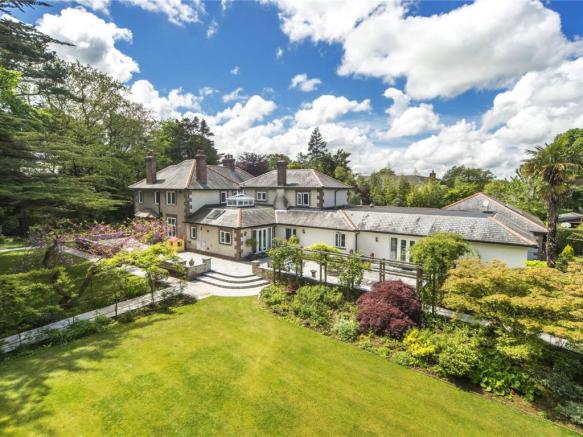
- Derek R Williams, ‘Robert Morton Nance: A Chronology’, pp 33, 35 in Peter Thomas and Derek R Williams, eds, Setting Cornwall on its Feet. Robert Morton Nance 1873–1959, London, , Francis Boutle.
- Brian Murdoch, ‘A Druid or something from the West Country’, p 48 in Peter Thomas and Derek R Williams, eds, Setting Cornwall on its Feet. Robert Morton Nance 1873–1959, London, , Francis Boutle.
- Derek R Williams, op. cit. p 34.
- Peter W Thomas, op. cit. p 208.
- Marriage Certificate of William Edwin Nance and Jane Morton, , from UK General Register Office Year 1867 Qtr S Vol 05c page 433.
- Marriage Certificate of Willmott Ayton Proctor and Phoebe Mary Morton Nance, , from UK General Register Office Year 1938 Qtr J Vol 05c page 469.
- Peter W Thomas, op. cit. p 182.
- Peter W Thomas, op. cit. p 193.
- Peter W Thomas, op. cit. p 191.